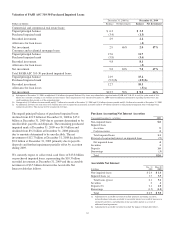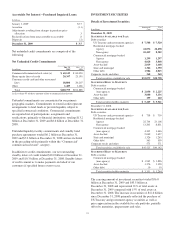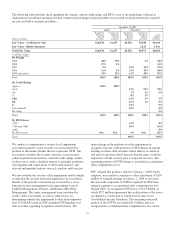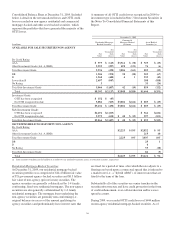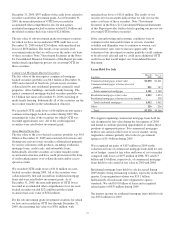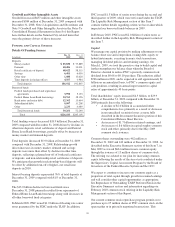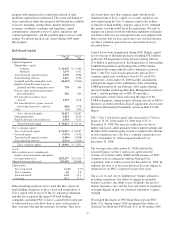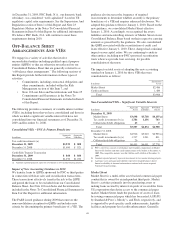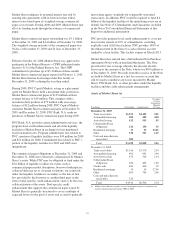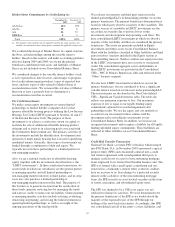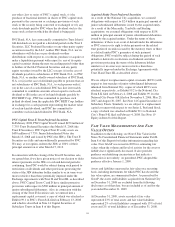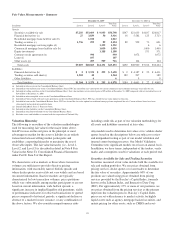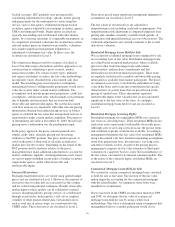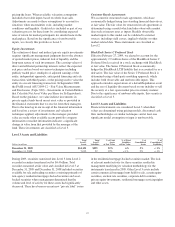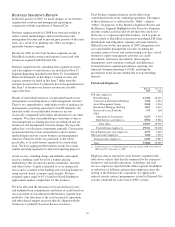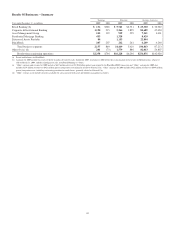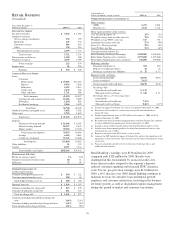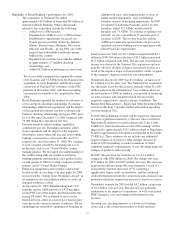PNC Bank 2009 Annual Report Download - page 46
Download and view the complete annual report
Please find page 46 of the 2009 PNC Bank annual report below. You can navigate through the pages in the report by either clicking on the pages listed below, or by using the keyword search tool below to find specific information within the annual report.
Market Street Commitments by Credit Rating (a)
December 31,
2009
December 31,
2008
AAA/Aaa 14% 19%
AA/Aa 50 6
A/A 34 72
BBB/Baa 23
Total 100% 100%
(a) The majority of our facilities are not explicitly rated by the rating agencies. All
facilities are structured to meet rating agency standards for applicable rating levels.
We evaluated the design of Market Street, its capital structure,
the Note, and relationships among the variable interest
holders. Based on this analysis and under accounting guidance
effective during 2009 and 2008, we are not the primary
beneficiary and therefore the assets and liabilities of Market
Street are not included on our Consolidated Balance Sheet.
We considered changes to the variable interest holders (such
as new expected loss note investors and changes to program-
level credit enhancement providers), terms of expected loss
notes, and new types of risks related to Market Street as
reconsideration events. We reviewed the activities of Market
Street on at least a quarterly basis to determine if a
reconsideration event has occurred.
Tax Credit Investments
We make certain equity investments in various limited
partnerships or limited liability companies (LLCs) that
sponsor affordable housing projects utilizing the Low Income
Housing Tax Credit (LIHTC) pursuant to Sections 42 and 47
of the Internal Revenue Code. The purpose of these
investments is to achieve a satisfactory return on capital, to
facilitate the sale of additional affordable housing product
offerings and to assist us in achieving goals associated with
the Community Reinvestment Act. The primary activities of
the investments include the identification, development and
operation of multi-family housing that is leased to qualifying
residential tenants. Generally, these types of investments are
funded through a combination of debt and equity. We
typically invest in these partnerships as a limited partner or
non-managing member.
Also, we are a national syndicator of affordable housing
equity (together with the investments described above, the
“LIHTC investments”). In these syndication transactions, we
create funds in which our subsidiaries are the general partner
or managing member and sell limited partnership or
non-managing member interests to third parties, and in some
cases may also purchase a limited partnership or
non-managing member interest in the fund. The purpose of
this business is to generate income from the syndication of
these funds, generate servicing fees by managing the funds,
and earn tax credits to reduce our tax liability. General partner
or managing member activities include selecting, evaluating,
structuring, negotiating, and closing the fund investments in
operating limited partnerships, as well as oversight of the
ongoing operations of the fund portfolio.
We evaluate our interests and third party interests in the
limited partnerships/LLCs in determining whether we are the
primary beneficiary. The primary beneficiary determination is
based on which party absorbs a majority of the variability. The
primary sources of variability in LIHTC investments are the
tax credits, tax benefits due to passive losses on the
investments and development and operating cash flows. We
have consolidated LIHTC investments in which we absorb a
majority of the variability and thus are considered the primary
beneficiary. The assets are primarily included in Equity
investments and Other assets on our Consolidated Balance
Sheet with the liabilities classified in Other liabilities and third
party investors’ interests included in the Equity section as
Noncontrolling interests. Neither creditors nor equity investors
in the LIHTC investments have any recourse to our general
credit. The consolidated aggregate assets and liabilities of
these LIHTC investments are provided in the Consolidated
VIEs – PNC Is Primary Beneficiary table and reflected in the
“Other” business segment.
We also have LIHTC investments in which we are not the
primary beneficiary, but are considered to have a significant
variable interest based on our interests in the partnership/LLC.
These investments are disclosed in the Non-Consolidated
VIEs – Significant Variable Interests table. The table also
reflects our maximum exposure to loss. Our maximum
exposure to loss is equal to our legally binding equity
commitments adjusted for recorded impairment and
partnership results. We use the equity and cost methods to
account for our investment in these entities with the
investments reflected in Equity investments on our
Consolidated Balance Sheet. In addition, we increase our
recognized investments and recognize a liability for all legally
binding unfunded equity commitments. These liabilities are
reflected in Other liabilities on our Consolidated Balance
Sheet.
Credit Risk Transfer Transaction
National City Bank, (a former PNC subsidiary which merged
into PNC Bank, N.A. in November 2009) sponsored a special
purpose entity (SPE) and concurrently entered into a credit
risk transfer agreement with an independent third party to
mitigate credit losses on a pool of nonconforming mortgage
loans originated by its former First Franklin business unit. The
SPE was formed with a small equity contribution and was
structured as a bankruptcy-remote entity so that its creditors
have no recourse to us. In exchange for a perfected security
interest in the cash flows of the nonconforming mortgage
loans, the SPE issued to us asset-backed securities in the form
of senior, mezzanine, and subordinated equity notes.
The SPE was deemed to be a VIE as its equity was not
sufficient to finance its activities. We were determined to be
the primary beneficiary of the SPE as we would absorb the
majority of the expected losses of the SPE through our
holding of the asset-backed securities. Accordingly, this SPE
was consolidated and all of the entity’s assets, liabilities, and
42


